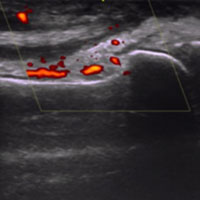Hand dominance in early and established rheumatoid arthritis: evaluation by dynamometer, Ritchie index and musculoskeletal ultrasound: a cross sectional study

Submitted: 5 February 2020
Accepted: 31 August 2020
Published: 19 November 2020
Accepted: 31 August 2020
Abstract Views: 1098
PDF: 663
Publisher's note
All claims expressed in this article are solely those of the authors and do not necessarily represent those of their affiliated organizations, or those of the publisher, the editors and the reviewers. Any product that may be evaluated in this article or claim that may be made by its manufacturer is not guaranteed or endorsed by the publisher.
All claims expressed in this article are solely those of the authors and do not necessarily represent those of their affiliated organizations, or those of the publisher, the editors and the reviewers. Any product that may be evaluated in this article or claim that may be made by its manufacturer is not guaranteed or endorsed by the publisher.
Similar Articles
- S.M. Günay, Z. Tuna, D. Oskay, Relationship between patient-reported and objective measurements of hand function in patients with rheumatoid arthritis , Reumatismo: Vol. 68 No. 4 (2016)
- S. Canestri, M.C. Totaro, E. Serone, B. Tolusso, D. Frezza, E. Gremese, G. Ferraccioli, Association between the response to B cell depletion therapy and the allele*2 of the HS1,2A enhancer in seropositive rheumatoid arthritis patients , Reumatismo: Vol. 64 No. 6 (2012)
- A. Marino, I. Pagnini, S. Savelli, D. Moretti, G. Simonini, R. Cimaz, Elbow monoarthritis: an atypical onset of juvenile idiopathic arthritis , Reumatismo: Vol. 64 No. 3 (2012)
- S.L. Bello, L. Serafino, C. Bonali, N. Terlizzi, C. Fanizza, C. Anecchino, G. Lapaldula, Incidence of influenza-like illness into a cohort of patients affected by chronic inflammatory rheumatism and treated with biological agents , Reumatismo: Vol. 64 No. 5 (2012)
- C.-N. Lo, G. Xia, B.P. Leung, The effect of nerve mobilization exercise in patients with rheumatoid arthritis: a pilot study , Reumatismo: Vol. 69 No. 3 (2017)
- M. Catanoso, N. Pipitone, C. Salvarani, Epidemiology of psoriatic arthritis , Reumatismo: Vol. 64 No. 2 (2012)
- M. S. Dag, I. H. Turkbeyler, Z. A. Ozturk, B. Kısacık, E. Tutar, A. Kadayıfçı, Cytomegalovirus ileocolitis in a rheumatoid arthritis patient: case report and literature review , Reumatismo: Vol. 67 No. 1 (2015)
- M. Capraro, M. Dalla Valle, M. Podswiadek, P. De Sandre, E. Sgnaolin, R. Ferrari, The role of illness perception and emotions on quality of life in fibromyalgia compared with other chronic pain conditions , Reumatismo: Vol. 64 No. 3 (2012)
- G. Lapadula, A. Marchesoni, F. Salaffi, R. Ramonda, C. Salvarani, L. Punzi, L. Costa, F. Caso, D. Simone, G. Baiocchi, C. Scioscia, M. Di Carlo, R. Scarpa, G. Ferraccioli, Evidence-based algorithm for diagnosis and assessment in psoriatic arthritis: results by Italian DElphi in psoriatic Arthritis (IDEA) , Reumatismo: Vol. 68 No. 3 (2016)
- Ş. Kobak, A. Berdeli, Fas/FasL promoter gene polymorphism in patients with rheumatoid arthritis , Reumatismo: Vol. 64 No. 6 (2012)
You may also start an advanced similarity search for this article.

 https://doi.org/10.4081/reumatismo.2020.1273
https://doi.org/10.4081/reumatismo.2020.1273




